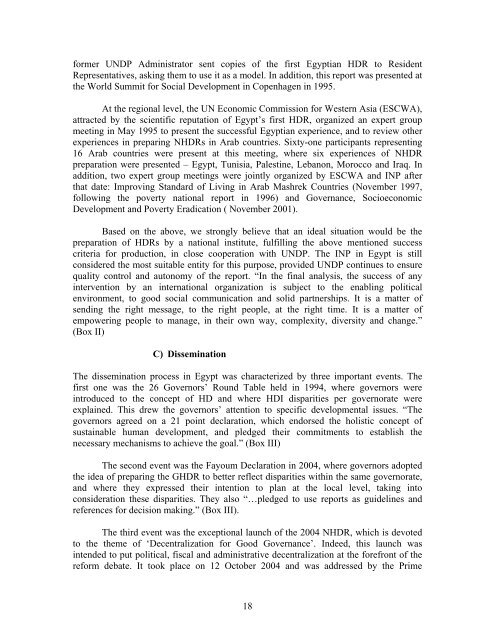Egypt - United Nations Development Programme
Egypt - United Nations Development Programme
Egypt - United Nations Development Programme
You also want an ePaper? Increase the reach of your titles
YUMPU automatically turns print PDFs into web optimized ePapers that Google loves.
former UNDP Administrator sent copies of the first <strong>Egypt</strong>ian HDR to Resident<br />
Representatives, asking them to use it as a model. In addition, this report was presented at<br />
the World Summit for Social <strong>Development</strong> in Copenhagen in 1995.<br />
At the regional level, the UN Economic Commission for Western Asia (ESCWA),<br />
attracted by the scientific reputation of <strong>Egypt</strong>’s first HDR, organized an expert group<br />
meeting in May 1995 to present the successful <strong>Egypt</strong>ian experience, and to review other<br />
experiences in preparing NHDRs in Arab countries. Sixty-one participants representing<br />
16 Arab countries were present at this meeting, where six experiences of NHDR<br />
preparation were presented – <strong>Egypt</strong>, Tunisia, Palestine, Lebanon, Morocco and Iraq. In<br />
addition, two expert group meetings were jointly organized by ESCWA and INP after<br />
that date: Improving Standard of Living in Arab Mashrek Countries (November 1997,<br />
following the poverty national report in 1996) and Governance, Socioeconomic<br />
<strong>Development</strong> and Poverty Eradication ( November 2001).<br />
Based on the above, we strongly believe that an ideal situation would be the<br />
preparation of HDRs by a national institute, fulfilling the above mentioned success<br />
criteria for production, in close cooperation with UNDP. The INP in <strong>Egypt</strong> is still<br />
considered the most suitable entity for this purpose, provided UNDP continues to ensure<br />
quality control and autonomy of the report. “In the final analysis, the success of any<br />
intervention by an international organization is subject to the enabling political<br />
environment, to good social communication and solid partnerships. It is a matter of<br />
sending the right message, to the right people, at the right time. It is a matter of<br />
empowering people to manage, in their own way, complexity, diversity and change.”<br />
(Box II)<br />
C) Dissemination<br />
The dissemination process in <strong>Egypt</strong> was characterized by three important events. The<br />
first one was the 26 Governors’ Round Table held in 1994, where governors were<br />
introduced to the concept of HD and where HDI disparities per governorate were<br />
explained. This drew the governors’ attention to specific developmental issues. “The<br />
governors agreed on a 21 point declaration, which endorsed the holistic concept of<br />
sustainable human development, and pledged their commitments to establish the<br />
necessary mechanisms to achieve the goal.” (Box III)<br />
The second event was the Fayoum Declaration in 2004, where governors adopted<br />
the idea of preparing the GHDR to better reflect disparities within the same governorate,<br />
and where they expressed their intention to plan at the local level, taking into<br />
consideration these disparities. They also “…pledged to use reports as guidelines and<br />
references for decision making.” (Box III).<br />
The third event was the exceptional launch of the 2004 NHDR, which is devoted<br />
to the theme of ‘Decentralization for Good Governance’. Indeed, this launch was<br />
intended to put political, fiscal and administrative decentralization at the forefront of the<br />
reform debate. It took place on 12 October 2004 and was addressed by the Prime<br />
18
















